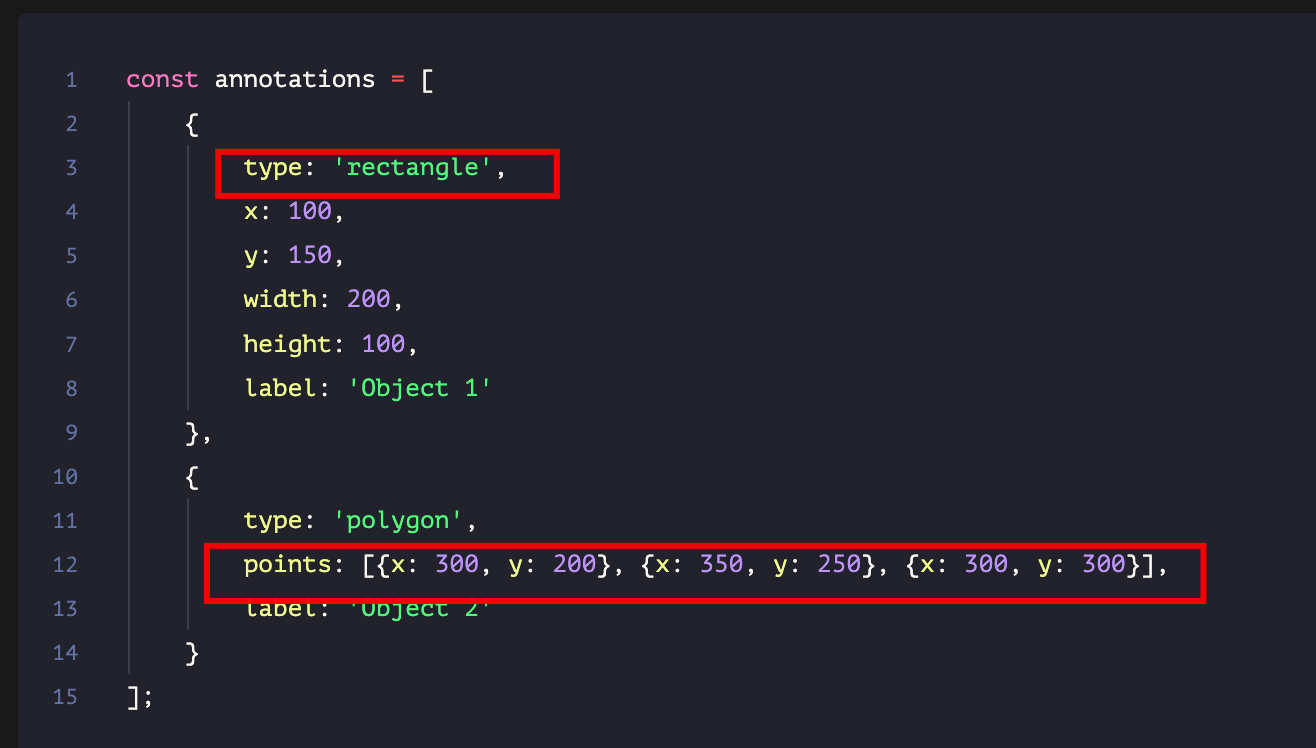UI 标记工具设计
#系统设计 #前端系统设计
目录
1. 总结
- 数据结构设计与存储
- 标记数据结构
- 标记数据结构
- 图像渲染和交互层
- canvas.addEventListener(‘mousedown、mouseup、wheel’) 等
- 绘制和编辑功能
- Canvas API
- 坐标系统和缩放处理
- 数据导出和集成
- 可导出 JSON 数据结构
- 更多特性
- 如多种标注形状、标签管理、撤销/重做功能、缩放和平移等
- 建议使用专门的库(如
Fabric.js或 Konva.js )
2. 原理
从下面几个关键点来解释这些工具的工作原理:
- 图像渲染和交互层
- 数据结构和存储
- 绘制和编辑功能
- 坐标系统和缩放处理
- 数据导出和集成
2.1. 图像渲染和交互层
const canvas = document.createElement('canvas');
const ctx = canvas.getContext('2d');
// 加载图像
const image = new Image();
image.onload = () => {
canvas.width = image.width;
canvas.height = image.height;
ctx.drawImage(image, 0, 0);
};
image.src = 'path/to/image.jpg';
// 添加交互层
canvas.addEventListener('mousedown', handleMouseDown);
canvas.addEventListener('mousemove', handleMouseMove);
canvas.addEventListener('mouseup', handleMouseUp);
这段代码展示了如何创建一个基本的画布并加载图像。
交互层通过事件监听器实现,允许用户与图像进行交互。
2.2. 数据结构和存储
对于标记数据,我们可以使用类似以下的数据结构:
const annotations = [
{
type: 'rectangle',
x: 100,
y: 150,
width: 200,
height: 100,
label: 'Object 1'
},
{
type: 'polygon',
points: [{x: 300, y: 200}, {x: 350, y: 250}, {x: 300, y: 300}],
label: 'Object 2'
}
];
这种结构可以轻松地序列化为JSON,方便存储和传输。
2.3. 绘制和编辑功能
绘制功能可以通过Canvas API实现:
function drawAnnotations() {
annotations.forEach(annotation => {
ctx.beginPath();
if (annotation.type === 'rectangle') {
ctx.rect(annotation.x, annotation.y, annotation.width, annotation.height);
} else if (annotation.type === 'polygon') {
ctx.moveTo(annotation.points[0].x, annotation.points[0].y);
annotation.points.slice(1).forEach(point => {
ctx.lineTo(point.x, point.y);
});
ctx.closePath();
}
ctx.stroke();
});
}
编辑功能可以通过检测鼠标位置是否在标注区域内来实现。
2.4. 坐标系统和缩放处理
处理缩放时,需要在原始坐标和显示坐标之间进行转换:
let scale = 1;
function scaleCoordinates(x, y) {
return {
x: x / scale,
y: y / scale
};
}
function handleZoom(event) {
const delta = event.deltaY;
scale += delta > 0 ? -0.1 : 0.1;
scale = Math.max(0.1, Math.min(scale, 5)); // 限制缩放范围
// 重新绘制画布
redrawCanvas();
}
canvas.addEventListener('wheel', handleZoom);
2.5. 数据导出和集成
数据导出可以简单地将annotations数组转换为JSON:
function exportAnnotations() {
return JSON.stringify(annotations);
}
3. React 简易实现
为了更好地理解这些原理,我们可以创建一个简单的UI标记工具的原型。这里我会使用 React 和 Canvas API 来实现一个基础版本:
import React, { useRef, useEffect, useState } from 'react';
const AnnotationTool = () => {
const canvasRef = useRef(null);
const [annotations, setAnnotations] = useState([]);
const [currentAnnotation, setCurrentAnnotation] = useState(null);
const [isDrawing, setIsDrawing] = useState(false);
useEffect(() => {
const canvas = canvasRef.current;
const ctx = canvas.getContext('2d');
const image = new Image();
image.onload = () => {
canvas.width = image.width;
canvas.height = image.height;
ctx.drawImage(image, 0, 0);
drawAnnotations();
};
image.src = 'path/to/your/image.jpg';
}, []);
const drawAnnotations = () => {
const canvas = canvasRef.current;
const ctx = canvas.getContext('2d');
ctx.clearRect(0, 0, canvas.width, canvas.height);
ctx.drawImage(image, 0, 0);
annotations.forEach(ann => {
ctx.beginPath();
ctx.rect(ann.x, ann.y, ann.width, ann.height);
ctx.stroke();
});
if (currentAnnotation) {
ctx.beginPath();
ctx.rect(
currentAnnotation.x,
currentAnnotation.y,
currentAnnotation.width,
currentAnnotation.height
);
ctx.stroke();
}
};
const handleMouseDown = (e) => {
const { offsetX, offsetY } = e.nativeEvent;
setCurrentAnnotation({ x: offsetX, y: offsetY, width: 0, height: 0 });
setIsDrawing(true);
};
const handleMouseMove = (e) => {
if (!isDrawing) return;
const { offsetX, offsetY } = e.nativeEvent;
setCurrentAnnotation(prev => ({
...prev,
width: offsetX - prev.x,
height: offsetY - prev.y
}));
drawAnnotations();
};
const handleMouseUp = () => {
setIsDrawing(false);
if (currentAnnotation) {
setAnnotations([...annotations, currentAnnotation]);
setCurrentAnnotation(null);
}
};
return (
<div>
<canvas
ref={canvasRef}
onMouseDown={handleMouseDown}
onMouseMove={handleMouseMove}
onMouseUp={handleMouseUp}
/>
<button onClick={() => console.log(JSON.stringify(annotations))}>
Export Annotations
</button>
</div>
);
};
export default AnnotationTool;
4. 总结
- 实际的 UI标记工具会更复杂,可能包括更多的特性,如多种标注形状、标签管理、撤销/重做功能、缩放和平移等。
- 上面的例子展示了核心原理
- 在实际开发中,可能会使用专门的库(如
Fabric.js或 Konva.js )来处理更复杂的交互和渲染需求。
